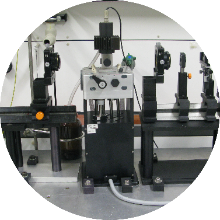The stopped-flow method is a strong technique to investigate the kinetics of reactions and structural changes (> 2 -20 ms) in solution via spectroscopic and scattering methods. Therefore, two or three reagents/solutions are mixed at adjustable rate and ratio in a mixing chamber before a detection device (see Fig. 1 for a schematic drawing). The flow of the mixture is then stopped spontaneously by a stopping piston (also called hard-stop) allowing to follow the adjustment of the new equilibrium as a function of time by different detection methods (e.g. UV/Vis spectroscopy, fluorescence spectroscopy, light scattering). Note that the stopped-flow method differs from the continuous flow method, in which the adjustment of the new equilibrium is studied along the flow path after the mixing chamber.
The stopped-flow device SFM-3000 from BioLogic is equipped with three driving syringes and two mixing chambers allowing for mixing three reagents/solutions in a two-step process at adjustable rate and ratio (see below). The dead time, specifying the time from the first contact of the solutions in the mixing chamber to the detection unit, strongly depends on the adjusted flow rate and varies from 2 to 20 ms. So far our setup allows only for the detection of transmission changes at a wavelength of 633 nm. However, two additional detection units (light scattering and fluorescence at a scattering angle of 90°) are planned to be installed in near future.
Specifications of SFM-3000 and transmission detection [3]
- mixing chambers: 2
- driving syringes: 3
- sample volume: 100 μl
- flow rate: 1 to 30 ml/s
- dead time: 2 to 20 ms
- light path: 1.5 mm
- laser output: 25 mW
- wavelength: 633 nm
|
[2] Atkins, De Paula: Atkin’s Physical Chemistry; Oxford Univ. Press |
|
[3] SFM-2000/3000/4000 User’s Manual, Version 2.1; BioLogic |

Julian Fischer
Post-Doctoral Researcher



